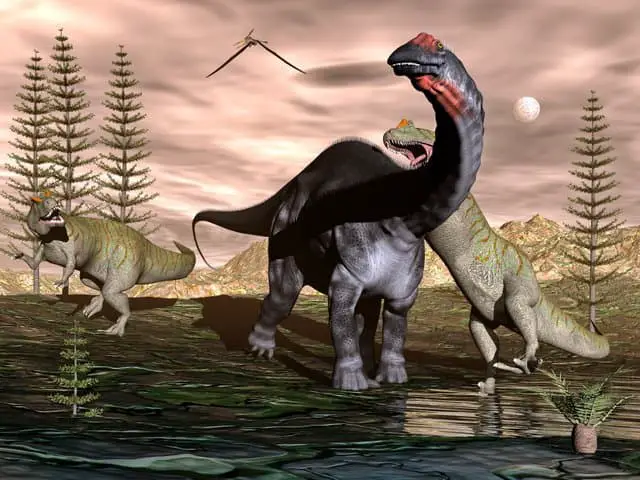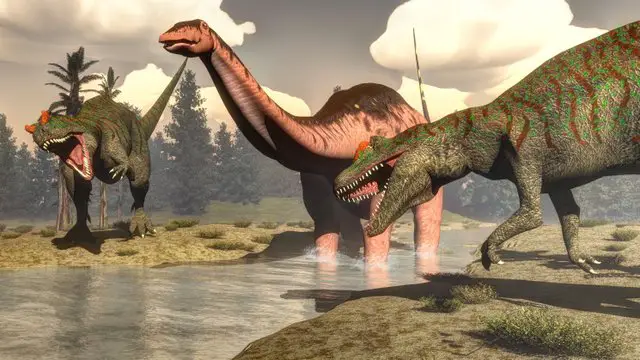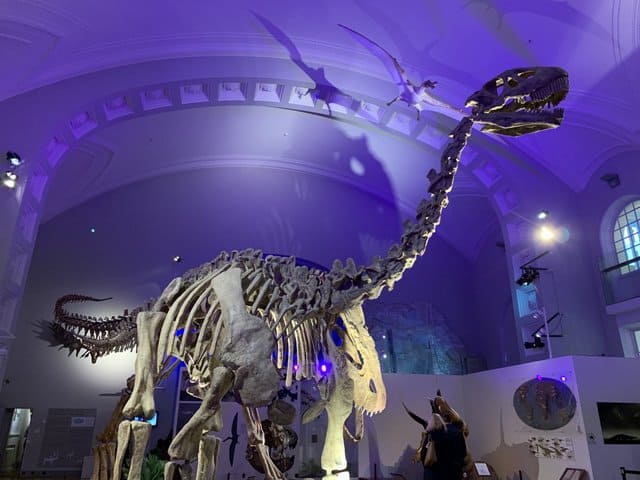The long neck sauropods were herbivorous dinosaurs considered to be the largest dinosaurs to have ever existed. They have characteristically long necks and their tails that were sometimes almost as lengthy. Between all these long appendages, these dinosaurs were heavy and are considered not to have moved quickly. In most places where sauropod fossils have been found, a predator like Allosaurus or T. Rex, or Giganotosaurus was also found in the same geographic area. Combining those factors, how did these dinosaurs avoid becoming dinner? How could they defend themselves against these aggressive predators?

How Did Long Neck Dinosaurs Defend Themselves?
So, how did long neck dinosaurs defend themselves? The essential methods were evasive measures such as herding together or escaping to lakes and rivers. If directly attacked, sauropods could use their long necks and tails as weapons to nudge or whip the predator. Some species had spikes on the body or on their necks that made the dinosaur harder to bite into. A few species even had clubs or spikes on their tails to further inflict damage on attacking predators.
During the Jurassic and Cretaceous periods, the long neck sauropods existed in Europe, the Americas, Africa, China, and Mongolia. Some of the most well-known sauropods are Diplodocus, Apatosaurus, Brontosaurus, and Brachiosaurus from North America.
In South America, sauropod dinosaurs such as Amargasaurus and Bajadasaurus existed in present-day Argentina, noted for their spiny necks. In Europe and Africa, smaller sized sauropods such as Ampelosaurus lived in France and Spinophorosaurus in Africa. Finally, in Asia, Nemegtosaurus lived in Mongolia, and Mamenchisaurus lived in China.
If you want to know more about sauropods and where they lived around the world, check out my articles What Are Long Neck Dinosaurs (Type, Size, Lists)? and Where Did Long Neck Dinosaurs Live – A Global Snapshot.
The predators that hunted long-neck dinosaurs depends on the period and geography. Interestingly, in most places where sauropod fossils have been found, there have been predators thought to have hunted these long neck sauropods.
During the Jurassic, the largest carnivores that may have hunted sauropods were Allosaurus in North America. During the Cretaceous, the apex predators were T. Rex in North America, the Giganotosaurus in South America, and Tarbosaurus in Mongolia.
In this article, we’ll elaborate further on how long-necked dinosaurs stayed alive. These creative measures are still fascinating to this day, so make sure you keep reading!
Evading Predators – Herding and Escaping to the Water
Long neck dinosaurs were herbivorous plant-eating dinosaurs. Paleontologists have long suggested that sauropods spent much of their time in or near the water and lived in herds. Sauropod footprints, found in places like France, the US, and Australia seem to confirm they spent time near the water.
The habitats that sauropods lived in were sub-tropical, with lots of waterways and rivers, lakes, and swamps created a natural way for sauropods to evade predators. Let’s start by looking at predators that may have hunted sauropods and discuss evasion methods of escaping these predators.
The Threat of Predators
Given that sauropods were plant-eaters, they didn’t intentionally try to cross the paths of other dinosaurs. However, that didn’t mean hungry dinosaurs didn’t target sauropods, especially the ferocious carnivorous dinosaur Tyrannosaurus Rex.
The threat from predators was a constant factor that sauropods needed to be ready for. It’s unknown if predators hunted in packs, but this would make them even more dangerous. Even with the largest sauropods, it would be difficult for a sauropod to escape if the carnivores hunted in packs.
Sauropods were large, so the size factor made them slow compared to the agile predators like Allosaurus, T. Rex, Giganotosaurus, or Tarborsaurus. There is also an intelligence factor. The EQ of sauropods is estimated to be 0.1, whereas carnivores had an EQ of 1.0 – 1.8. If you are interested to learn more about dinosaur intelligence, check out my article Smartest Dinosaur Species – Hunters That Could Outsmart Its Prey.
Herding
Paleontologists believe that sauropods may have taken the safety in numbers approach, staying together in herds. If a T-Rex or another hungry dino like the Giganotosaurus or Allosaurus saw just one sauropod, that’s an easy and quick lunch. In a group, though, the predator is outnumbered, so they don’t even bother trying.
It’s not even necessarily that the sauropods would instinctually gather if they sensed a threat. Many sauropods may have lived in groups, so it was natural for them to travel with several other dinosaurs at once.
Sauropod footprints have been found with seemingly multiple long neck dinosaurs traveling together, which indicate they not only herded together but also traveled together.
Escaping to the Swamps, Lakes, and Rivers
One such method sauropods would use to get away from the Tyrannosaurus was evasion. If the sauropod was being hunted, it would escape to safer, wetter places such as swamps, rivers, or lakes. It is not likely that a T. Rex could effectively swim in deep water, although it could wade in shallow water. The size of sauropods might enable it to go into water deeper than the T. Rex would be comfortable with.

Was this an effective method used by sauropods? We will never know for sure, however, there are instances of modern animals using evasion to water to escape from predators.
Necks and Tails as Defensive Weapons – How Sauropods Used It For Defense
If a predator is after a sauropod and separated from the herd and cannot escape to the water, it puts the long neck dinosaur in a tough predicament.
Sauropods didn’t have sharp teeth with which to bite predators. They were designed for chewing vegetation, being cone-shaped and flat. The claws of the sauropods like Apatosaurus ajax and Brachiosaurus from North America were blunt and not sharp.
Additionally, as they were quadrupeds – walking on all four limbs, their claws would not help much to slash attacking predators.
It’s possible that dinosaurs like Brachiosaurus, who were thought to sit back on their hind legs, could try and defend themselves against a Tyrannosaurus Rex.
Still, paleontologists believe that sauropods used this posture primarily for reaching vegetation at the top of the trees. Also, there is the possibility it could be tipped over by a charging predator, making this move fairly risky.
So with these options for a defense being limited, that leaves its long neck and long tail.
Sauropod Anatomy – What Could it Use to Defend Itself?
Let’s back up and take a look at the anatomy of a sauropod.
Sauropod dinosaurs, the name coming from the Greek, meaning “lizard-footed,” had a small skull, a long neck, an equally long or longer tail, and a massive body. In terms of
The anatomy of a sauropod dinosaur had these characteristics:
● Weight and Length– Massive sizes of sauropods – adult sauropods like the Patagotitan measured 122 feet (37.2 meters) and weights as much as 77 tons.
● Skull – The skull size of a sauropod was small in comparison to its body. It is estimated that the EQ, which measures intelligence by comparing bodyweight vs. brain size, ranks 0.1 on this scale, suggesting just how small sauropod skulls were compared to other dinosaurs’ skulls.
● Teeth– they were designed for grinding vegetation. They were rather flat in shape, having rows in the upper and lower parts of the jaw.
● Neck and Neck Vertebrae – Many sauropods have been found with full neck vertebrae, which helps paleontologists determine the dinosaur’s length. Scientists suggest that sauropods held their necks in an “S” shape for balance.
● Legs and Trunk (body)– Most of the species are three-toed. In many species, the front legs are longer than the hind legs, which paleontologists suggest enable “standing on the hind legs.” Also, on some species, the toes had claws. The trunk of the long-neck dinosaur was massive and from sauropod tracks estimate that they held their weight mostly on the back legs.
● Tail and Tail Vertebrae: Complete specimens of sauropods with their tail vertebrae intact have been discovered. Paleontologists suggest that they did not drag their tail as sauropod tracks have not been discovered with tail indentations.
Sauropod Necks as Defensive Weapons
What about the neck of a sauropod? Could this be a weapon as well? Consider that sauropods all have typically tiny heads. Those wouldn’t be reliable for attacks. This dinosaur mailing list archive from 1995 suggests a sauropod’s neck could become a weapon since the head could not be one.
As the listing mentions, most sauropod necks are quite muscular and thick, and giving a neck shove would be a devastating blow due to the size of the long neck dinosaurs.
Have you ever seen giraffes fight? If not, here’s a video. Sauropods could have similarly used their necks to applying a neck shove, wrap-around, and injure other dinosaurs that got in their way. (What are long neck dinosaurs – article video of giraffes)
In 2013, University of Oregon professor Kent Stevens created a visual illustration of how a sauropod could move its neck in different ways to swing, raise, lower, or go side to side. Here is a link to his simulation, which he created using a digital skeleton.
Stevens also said that most sauropods likely did not raise their long necks but rather kept them level to the ground. Other experts believe sauropods may have fed on the ground cover as well. Research like the Independent article disagrees and says the dinosaur species would eat food sources higher than what the average dinosaur could reach.
The Spinosophorosaurus’ Neck and Its Similarity to Giraffe Necks
The Spinophorosaurus lived in Middle Jurassic times in the land known today as the Republic of Niger. The world didn’t discover this fascinating dinosaur species until the early 2000s when Spanish and German paleontologists unearthed the fossils with great difficulty.
To get a full picture of what the Spinophorosaurus might have looked like, 3D skeletal printing was employed, the first time that ever happened in this context. What’s even more amazing is that this dinosaur’s discovery represents one of the complete fossilized sauropod necks.
What do we know about this sauropod? The Spinophorosaurus was 43 feet long in adulthood with a height of 13 feet from the ground to the shoulders alone. As with other sauropods, the Spinophorosaurus was heavy, weighing about seven metric tons. It had a small head with a short braincase, which is no surprise.
Now, about the neck. The 13-vertebrae neck included dorsal vertebrae with internal chambers filled with air. Its large rear didn’t move much due to chevron bones, including some which overlapped. That said, the tail of the Spinophorosaurus was muscular and strong.
When the Spinophorosaurus was studied in 2015 through 3D modeling, the experts believed the tail of this sauropod could move up to 20 degrees when deflecting and up to 10 degrees when flexing sideways.
Later, in 2020, more 3D modeling focused on the neck flexibility of a Spinophorosaurus. The experts stated that how giraffes move their necks today was possible of the Spinophorosaurus back in the Jurassic Period days. Besides being flexible enough to eat vegetation from multiple angles, it also indicates that it could have used its neck for defense.
Sauropod’s Long Tail – How Could It Be Used in Defense?
The long neck of a sauropod evolved so they could eat. Most food sources these dinosaurs fed on were tall trees. With the length of their necks, sauropods could easily reach the trees and munch on vegetation.
Yet that’s not the only way a sauropod may have fed on trees. According to this article from the UK resource Independent, sauropods would use their tails in the same way we humans use a step stool when we can’t quite reach something.
The long-necked dinosaur would stand on its back legs, shifting its center of gravity nearer to its hip joints. It would allow the hind legs to support the dinosaur’s weight, which experts believe was also true if a sauropod stood up.
What does this have to do with using a tail as a defensive weapon? A lot. The design of a sauropod’s massive tail was such that the base was heavy, but the end tapered, almost like a whip.
When Nathan Myhrvold at the Microsoft Corporation modeled the Diplodocus on a computer to understand more about how it ate, the Independent article mentions that the research uncovered how the sauropod could use its tail as a weapon.
Since the tail is thicker at the base and thinner at the tip, a sauropod could move its tail quickly, gaining and conserving momentum as it did. The article states that “if the tip [of the tail] is thin enough in comparison to the base, it may exceed the speed of sound and a crack – in fact, a miniature sonic boom – will be heard.”
The Diplodocus had such a tail that could have caused these sonic booms, which is pretty cool!
Shunosaurus lii
One species of smaller sauropod possibly used its tail as a weapon against predators in a different way. The Shunosaurus lii from Sichuan, found in 1977 initially by students, and then later paleontologists found multiple skeletons of adults and juveniles.
It has resulted in 94% of the skeleton identified, including a complete skull. It lived during the Late Jurassic and was a smaller sauropod than the North American or South American counterparts.
When it comes to defense, scientists have determined from skeletal fossil remains that the Shunosaurus had a club on its tail, and in adults, this club also had four spikes, a row of two spikes each.
It indicates that for defense purposes, its tail could be used to swing and hit the predator. Although the Shunosaurus’ tail was not as long as other sauropods, it still could generate a lot of swinging power. With the club and spikes on end, considerable consequences would happen if it hit the predator.

I recently visited the Helsinki Museum of Natural History, where they have a replica of the Shunosaurus lii – an amazing fossil! Indeed, at the end of the tail was a club and four spikes.
Long-Neck Dinosaur Neck Spikes – Which Species Had These Spikes?
I have discussed how sauropods used their neck and tail to fend off predators, and this could have been an effective way for a long neck dinosaur to defend themselves.
There was yet a third method that sauropods could use to ward off predators, and that was by using different kinds of armor, in particular, spikes that ran down their neck and along their back.
A few species of sauropod dinosaurs actually did have armor to defend themselves, with spikes that lined their bodies. It wasn’t a trait of all long-necked dinosaurs. Only a few species have been found globally, and I’ll cover the ones from South America: the Amargasaurus and the Bajadasaurus from Patagonia in Argentina.
Here’s an introduction to these cool spiked-neck armored dinosaurs.
What Kind of Spikes Were They?
The neck spikes of the Amargasaurus and Bajadasaurus are found on both fossils of these dinosaurs, and the Amargasaurus has a complete fossil specimen. Paleontologists think that sauropods could have used these spikes for defense because of the length and position they were pointing.
It should be noted that both these dinosaurs had smaller-sized necks than other sauropods.
The neck spikes, or neural spines as paleontologists call them, were actual bone growth from the vertebrae, and these tall spines reached 24 inches (60 centimeters) long in the middle of the neck of the Amargasaurus. In the Bajadasaurus, the longest neural spines were 23 inches (58 centimeters), again towards the middle of the neck.
————————————————————————————————
Related Sauropod Articles You Might Also Be Interested In:
Herbivore Dinosaurs – What’s So Cool About Them? (Types, Sizes, Facts)
Where Did Long Neck Dinosaurs Live? A Global Snapshot
What Are Long Neck Dinosaurs (Types, Size, List)?
————————————————————————————————
Amargasaurus
The Amargasaurus, which translates to La Amarga lizard, lived during the Early Cretaceous days in the land known as Argentina – the Cretaceous of Patagonia. We’ve got a nearly complete picture of what this dinosaur species looked like in all the subsequent research.
Additionally, the fossil skeleton with a complete skull is almost 100% complete, giving lots of insight into these types of sauropods from this area.
The Amargasaurus was probably reached about 8.9 feet tall with a snout that was 31 inches over ground level. It’s also important to note that this species is classified as a Dicraeosauridae (as relative to diplodocus-like dinosaurs), which still makes the Amargasaurus a sauropod, but one with a smaller body and a neck that’s not quite as long.
On average, an adult Amargasaurus was 33 feet long, so it wasn’t small by any means, but it was lighter-weight at 2.6 metric tons. The Amargasaurus had spikes along the back of its neck. These neural spines reached 24 inches (60 centimeters) long.
No one is admittedly quite sure what the spikes were used for, but we can make a couple of guesses. The Amargasaurus lacked the long tail typical of sauropods. Its tail was broad enough at the base and tapered enough at the end that it could be swung as we described in the last section. However, since the tail wasn’t as long, swinging around would have to be done at a shorter range.
The same would have been true of the Amargasaurus’ neck, which was lacking compared to other sauropods. It would have again called for close-range combat. To protect itself so that predators couldn’t get too close, the Amargasaurus could have developed and evolved its long spikes.
Bajadasaurus
The Bajadasaurus pronuspinax is another sauropod dinosaur that was found in Argentina. Like the Amargasaurus, it had a shorter neck and neural spines that were part of the vertebrae.
The Bajadasaurus lived during the Early Cretaceous period, and its fossils were found in Patagonia in Argentina in 2010, although full description and classification of the dinosaur didn’t happen until 2019. It was found in the Bajada Colorada formation.
The fossil remains of the Bajadasaurus pronuspinax were limited. Only a partial skull and a few of the vertebrae were preserved. However, the vertebrae’s neural spines were curiously directed towards the front, unlike the Amargasaurus, directed backward. However, the neural spines were considerably longer, one of them measuring 23 inches (58 centimeters).
Final Thoughts
We hope this post has given you an even greater appreciation for the amazing sauropods!
As long neck sauropod dinosaurs are recognized as being the largest dinosaurs on earth. It’s also interesting that predators hunted them. During the Jurassic period of North America, Apatosaurus and Diplodocus possibly were hunted by Allosaurus and Ceratosaurus.
The great Tyrannosaurus Rex probably threatened Alamosaurus during the Cretaceous period. In Argentina, the Giganotosaurus was likely to hunt the Amargasaurus or Bajadasaurus.
That makes long neck sauropod defensive actions and abilities highly important if they wanted to survive these predators’ attacks. It would be interesting to find out one day if these evasive techniques and body armor such as neck spines were effective in stopping predators. Maybe the next fossil finds will give us more clues.
